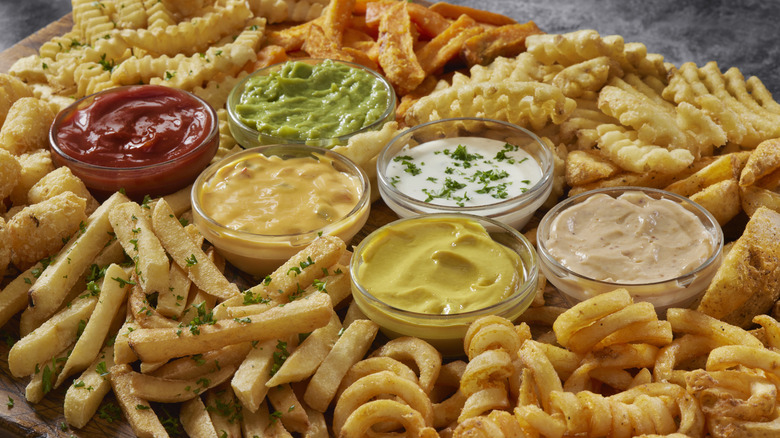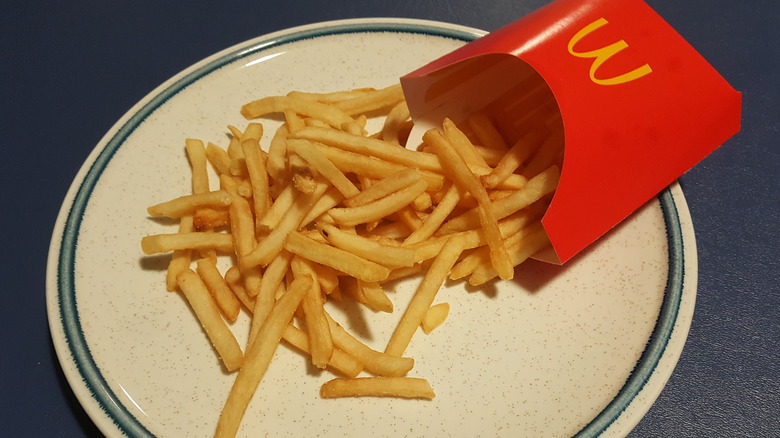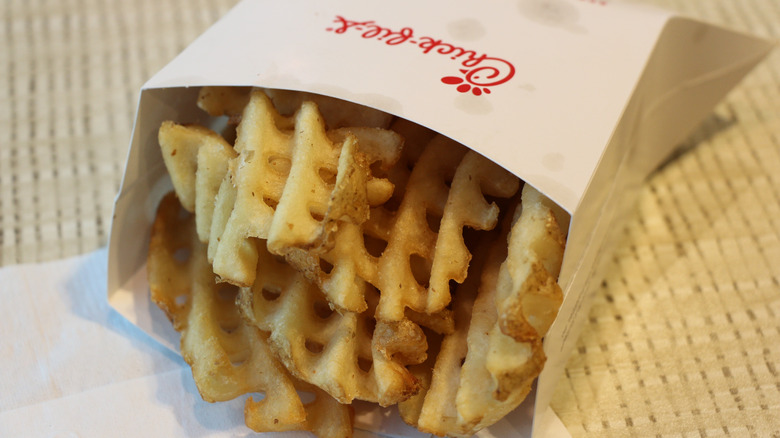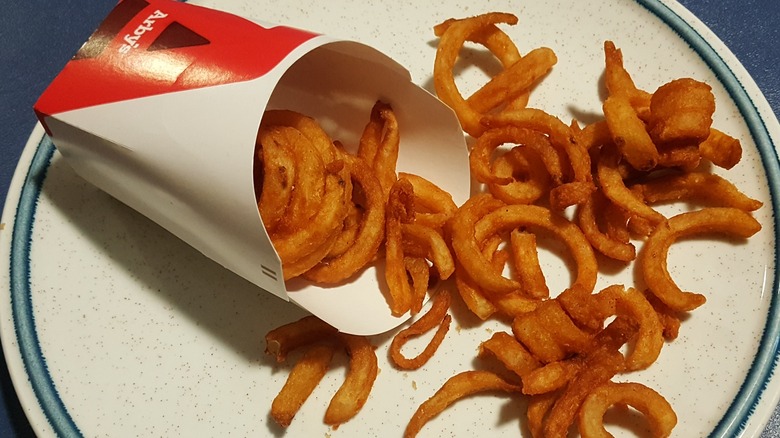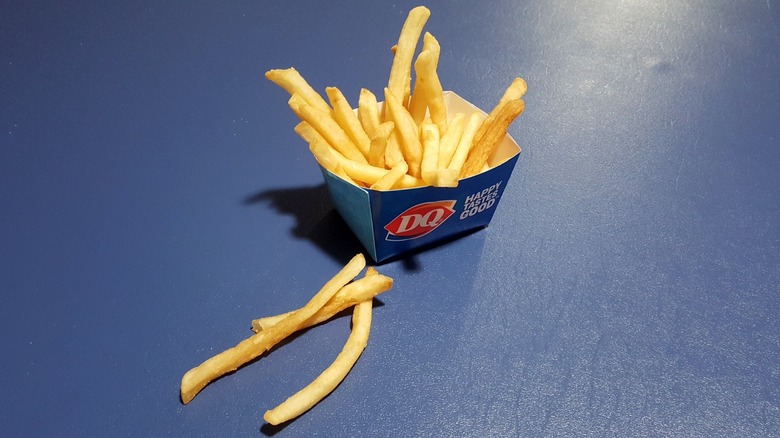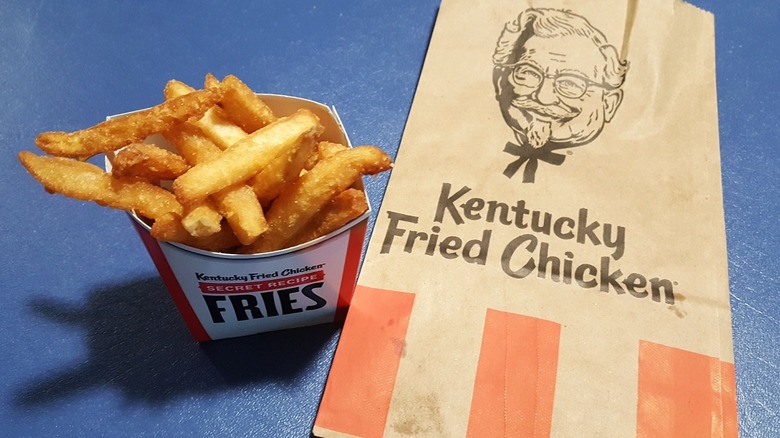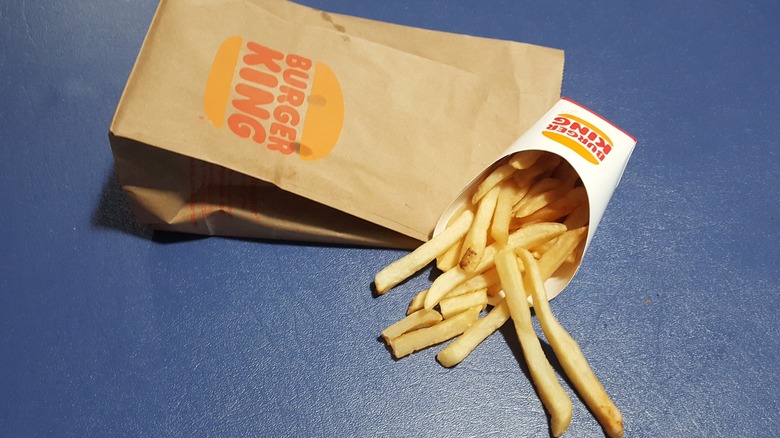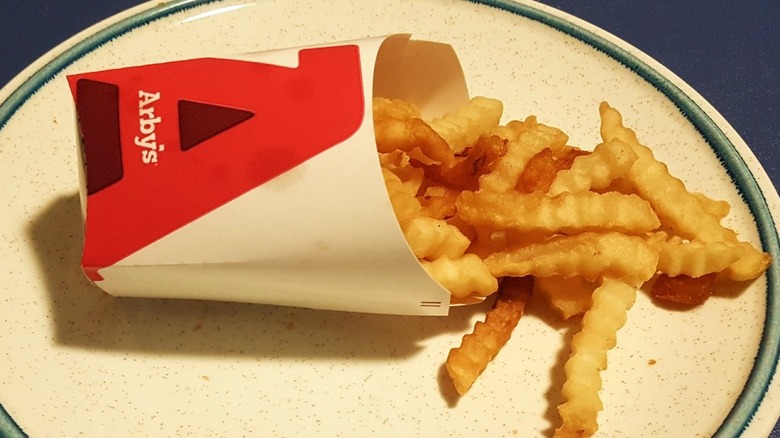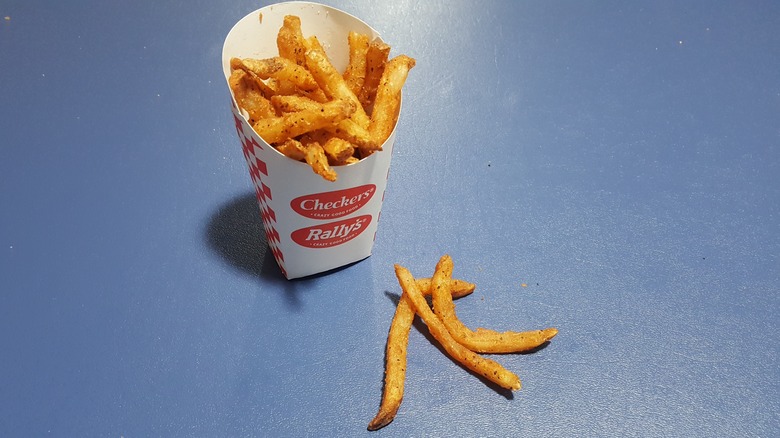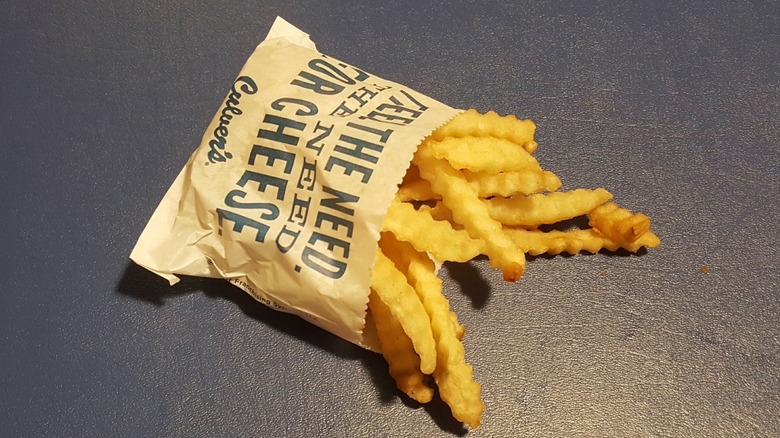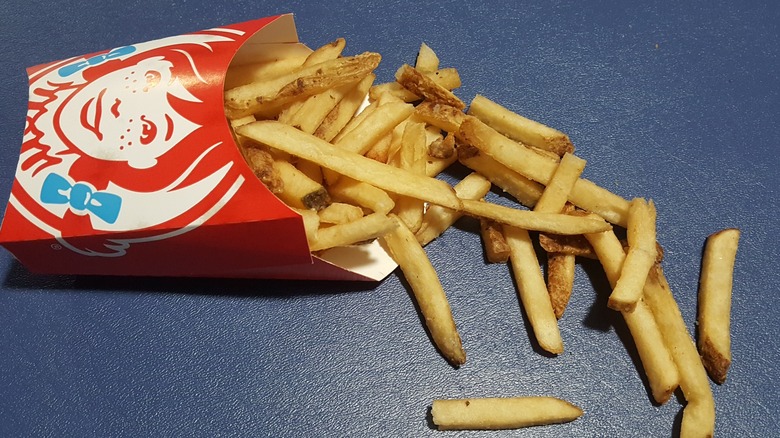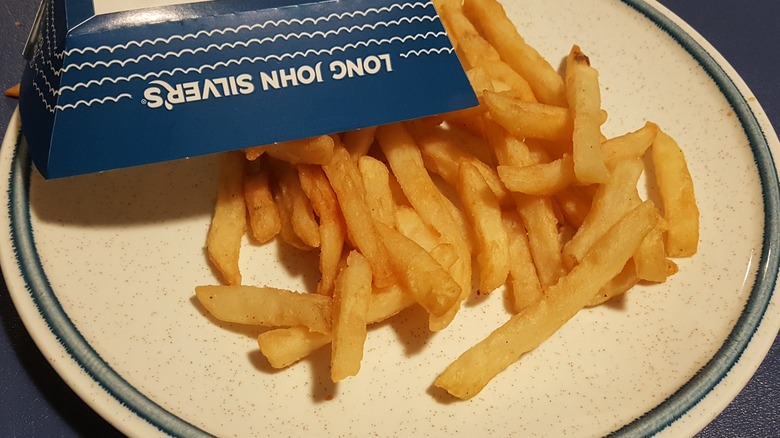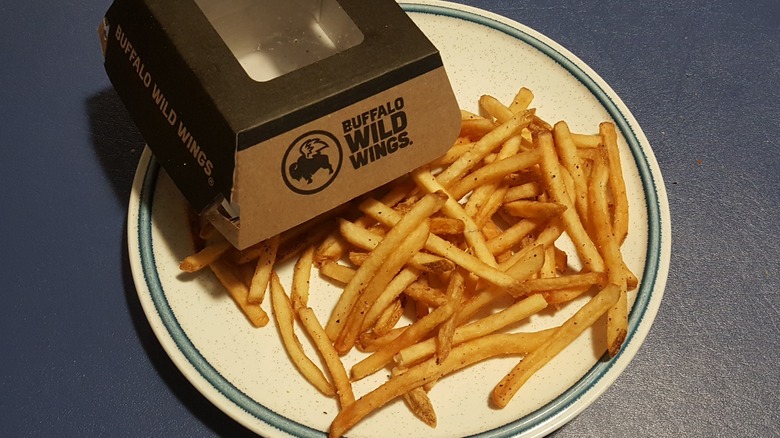The Best Fast Food French Fries In Each Shape
Fast food chains serve different shapes of fries, and that variation in style affects your sensory experience when eating them. Close your eyes, and picture the last time you munched on this side dish. In your mind, you may see long, thin, pale sticks with just a blush of tan on the corners. Maybe you visualize caterpillar-like crinkle-cut fries. You might also think of brown, toasty crisscrossed waffle-cut fries or curlicues. Do the fries in your mind's eye have bits of skin on them or a rough outer layer covered in spices?
If you're still imagining what your last french fry looked like, take that mental image between your index finger and thumb, and pop it into your mouth. Feel the crunch of the outer layer between your teeth as it gives way to the creamy, fluffy inner potato that sort of pleasantly squishes out onto your tongue. Salt tingles across your taste buds, and you wash it down with an impossibly sweet soft drink. Grab a brown, fast food napkin to wipe salt-speckled grease from your fingertips and, then, reach for another fry.
You likely already have a favorite haunt where you get your french fry fix, but there are a lot of options out there in the fast food world. You could be missing out on some fantastic fries, in a new shape, from a chain you haven't tried yet. So, open your mind, and step into the marvelous world of fast food french fries.
McDonald's thin-cut fries
McDonald's fries set a gold standard in the quick-service restaurant industry. For years, McDonald's has been the largest fast food chain, and its fries are a top earner — it sells more than 3.29 billion pounds of them every year, according to Zippia. After soft drinks, this side brings in the most money since it requires minimal labor, and the markup is a large percentage of the sale price. That means the Golden Arches works extra hard to make its fries attractive.
McDonald's fries are slim, long, and very consistent — you won't find many short, brown, or broken fries in the red carton. Their color is a gorgeous golden hue, which makes them even more appealing. They are perfectly crispy on the outside, mushy on the inside, and so salty you can barely taste the potato in them.
If you're craving some fries, head to McDonald's, and you won't be disappointed. Swing by on a Friday, and you can get a medium order for free when you spend more than $1 through the McDonald's app through the end of 2023. Go there any other day, and you'll find that an order of medium fries is about $0.20 more expensive than at the competition. A quick warning, though — vegans, vegetarians, and people on gluten-free diets should avoid this product. The company's recipe includes beef flavoring and wheat derivatives.
Chick-fil-A's waffle fries
You'll find the waffle fries you've been dreaming about at Chick-fil-A. These crisscrossed-shaped fries have some major benefits. For example, they have more surface area that gets crunchy when fried up. Then, the ridges catch and trap salt or any sauce you choose to dip them in, making them extra flavorful. Another point for Chick-fil-A's fries is they're free of allergens like milk, eggs, and wheat and also vegetarian and vegan-friendly. Kudos to Chick-fil-A for making an extra effort for people on these special diets — not every chain does.
The sensation of a waffle fry in your mouth is completely different than eating the more common thin-cut fries. The wider surface area comes into contact with more of your tongue, and you have to take a heartier bite. These fries have the same crunchy exterior and fluffy interior as other fries, but you get more of the flavor and texture all at once.
Waffle fries have a dark secret though: They're harder to share with friends. Get a large order of thin cuts, and everyone can grab a few. But waffle fries run out much quicker because each fry is bigger so there are fewer in each carton — by some counts, just around 13 in a large order. That means you'll also miss out on the loose fries that spill out onto the bottom of the take-out bag. Finding those is like finding hidden treasure.
Arby's curly fries
Curly fries are the most fun shape of french fry, and you can get them at Arby's. Who wouldn't want to eat miniature Slinkys made of potato? To produce these fries, machines at manufacturing plants form potatoes into springs by spinning and slicing each vegetable into a long string — you can get an idea of how that works by watching a video of a home kitchen spiralizer. Usually, these long strips of potato break down into smaller pieces as they're processed and fried, but some still come extra long — about 10 inches if you get lucky. Families with kids may have a great time seeing who has the longest fry next time you all eat at Arby's.
The curly fries at Arby's are orangish-brown and have a rough outer texture. That's because they're covered in a batter with plenty of paprika and other seasonings. The strongest flavor that comes through is onion, though — forget about tasting the potato in them. The first few bites are delicious, but eat a whole medium order, and it will overwhelm your palate. It's best to share these.
People on gluten-free diets should avoid these curly fries since they contain wheat. Additionally, Arby's uses the same oil to make fries and to fry fish when it's on the menu, so vegans and vegetarians should also stay away from this Arby's side dish.
Dairy Queen thin-cut fries
You may think of Dairy Queen as a place to get ice cream, but it's also a fantastic spot to pick up some thin-cut fries. In fact, they're everything fries should be: crisp on the outside, soft on the inside, and delightfully salty. These fries taste sufficiently potatoey, which cannot be said of all fast food fries. They are beautifully golden and come in long, uniform pieces. Dairy Queen's fries aren't usually broken into small pieces or burned.
The carton is one of the nicest things about Dairy Queen's fries. It has lower sides, but a wider bottom. Most restaurants serve their fries in cartons that have narrow bottoms and wider tops, making them unstable. The packaging from other chains doesn't stand up or balance well, especially when the bottom isn't tucked in properly. If you're worried about your fries falling out onto a restaurant table of questionable cleanliness or in the car, Dairy Queen's french fry packaging is the answer to your prayers.
Additionally, these fries are vegetarian — they don't contain any fat or flavoring that comes from animals, and they're gluten-free. Before digging in, though, ask your local franchise if they use the oil to fry anything else to prevent cross-contamination.
KFC's thick-cut, rough fries
KFC is big on secrets (it famously keeps the recipe for its fried chicken spice blend in a locked vault), and its fries are no exception — they're called Secret Recipe Fries. When you get an order, you'll certainly wonder what the chain does to make the fries look so rough on the outside. Is it batter? Is it how the potatoes are prepped? Those same questions mean it's unclear whether vegetarians or people with wheat allergies can eat these fries, but to stay on the safe side they should avoid them.
KFC invented a special blend of spices, and that makes these fries unique — there is no other fry out there that tastes the same. The rough outer texture makes them extra crispy, and they're cut thicker than most other fries, making them a little heartier. They aren't for everyone, though. You'll either love them or hate them — there's no middle ground. If you want potato flavor, you won't be impressed. If you want something that fulfills your grease-salt-spice-crunch craving, these will hit the spot perfectly. Share them with someone else, though, since the intense flavor can get unpleasant if you eat too many.
Burger King thin-cut fries
Ever since the Satisfry fiasco of 2013 when Burger King unsuccessfully peddled lower-calorie crinkle cuts, the chain has stuck to plain thin-cut fries just like its main competitors, Wendy's and McDonald's. The thin cuts from Burger King are golden and delicious — crispy, fluffy, and salty — not so different from any other thin-cut fry. Burger King does a good job keeping these fries uniform — you won't find many broken or short fries in your carton. The price, while cheaper than McDonald's, is identical to Wendy's. If you're craving thin-cut fries and there's a Burger King nearby, you'll like what you get. In other words, Burger King makes a solid thin fry at a low price.
The chain has also recently distinguished itself by offering more plant-based foods, including the Impossible Burger and its fries. They are fried in vegetable oil and don't contain any animal products for flavoring. Burger King's fries don't contain any wheat either, but some franchises use a shared fryer, so gluten contamination from other products is a concern.
Arby's crinkle-cut fries
Crinkle-cut fries appear on fast food menus less often than thin cuts, but you can find them at Arby's. Crinkle cuts have little ridges along their length. This should give them more crunch and surface area to catch salt. In practice, it doesn't work as well as it does in theory. Since crinkle cuts are thicker, you end up with more soft inside potato and less outer crunch than when you indulge in thin-cut fries.
An additional problem with Arby's crinkle cuts is that the chain uses the same fryer for several products. That could include fish or curly fries. As a result, your crinkle-cut fries may come mixed with a few curlies in the carton. If you don't like the seasoning Arby's uses on its curly fries, you probably don't want it rubbing off on your crinkles. The shared oil also means the fries can come out tasting like something else in addition to potato, salt, and oil. That additional flavor is likely unwelcome. The shared fryer means cross-contamination with meat or fish products is an issue for vegetarians. Additionally, Arby's lists wheat as an ingredient, so people on gluten-free diets should watch out.
Rally's thin-cut, seasoned fries
Rally's offers just one type of fries: seasoned. They may look a little overdone, but that darker color is actually due to the seasoned batter that coats them. They're most similar to KFC's seasoned fries in appearance and price — both are more expensive than the fries from Arby's, Wendy's, or Burger King by about $0.50-$1. Of course, when you compare just two types of seasoned fries, one has to come out as superior, and it's not Rally's. There's nothing inherently wrong with these fries, but their texture isn't as crispy as KFC's, and the spice mix isn't as delicious. They're also more slender. A little more potato with the spice mix would be nice, so their thinness isn't favorable.
Seasoned fries all have the same issues: They don't taste like potatoes, and the spices get off-putting once you've eaten more than three. Yet, if you're looking for something salty and greasy, Rally's fries will most certainly hit the spot unless you're on a gluten-free diet, in which case you'd better skip them.
Culver's crinkle-cut fries
Culver's makes solid crinkle-cut fries. If you like this style, you should head to the frozen custard expert for your fry fix. They're nice and crispy on the outside and taste like fluffy potatoes on the inside. If you like a higher fluff-to-crunch ratio, these fries are for you. The chain fries them to perfection — they're not underdone, and they're never burned.
The biggest problem with Culver's fries is the packaging. They come in a paper bag. If you're getting them as takeout, this could be a problem because that bag will let grease seep through on whatever you set them on — like the upholstery in your car. If you get home and set them on the table, that will get greasy as well, so you'll probably have to put them out on a plate. You bought fast food so you would not have to do any cleanup, so the plate is counterintuitive.
Finally, people on gluten- or wheat-free diets should know that Culver's uses shared frying oil, so there may be cross-contamination, but wheat is not an ingredient. Vegetarians can indulge in these fries.
Wendy's thin-cut fries
Wendy's has set itself apart from the competition by saying that its meat has never been frozen. Likewise, the chain strives to show its fries come from fresh potatoes: Its thin-cut fries have part of the peel on them. This doesn't affect the taste, but it does give them a more authentic appearance. A glance at the ingredient list reveals these fries have just as many preservatives and additives as any other chain.
The taste of these thin cuts is similar to the competition — crisp on the outside, squishy in the middle, and plenty salty. They taste like fried potatoes. The biggest down point to these fries is that many of them come in shorter bits or are broken off, making them more tedious to eat. Wendy's doesn't add any wheat or animal products to its fries, but it does use the same fryer, possibly causing cross-contamination.
Long John Silver's thick-cut fries
Long John Silver's menu mostly lists fish and seafood, but there are fries on there as well. Of course, this fast food chain couldn't overlook the opportunity to serve traditional fish and chips, so it offers the thickest, stubbiest fries of all the chains. They come in a low wide carton. This packaging won't tip over, so if you're sharing your fries with kids, that's handy. The fries themselves taste like buttery mashed potatoes with a crisp salty exterior — the way fries should taste. Like crinkle fries, they have a higher fluff-to-crisp ratio and are mouthwateringly delicious. They're also cheaper than the next lowest-costing fast food fries by about $0.10. So there are several good reasons to head to Long John Silver's next time you want something a little heartier than thin cuts.
Wheat is listed on the ingredients of these fries, and they share oil with the Long John Silver's battered fish, so people with special diets like gluten-free or vegetarian shouldn't eat these fries.
Buffalo Wild Wings' thin-cut fries
Buffalo Wild Wings fries come with a beautiful presentation. They have a nice lidded box with a window — that means if you've got a big complicated order for lots of people, you can find the fries at a glance. The lid means the fries won't fall out all over the place in the car on the way home, and the wide bottom of the carton prevents it from tipping once you've set it on a stable surface.
The fries themselves come in long neat sticks — very few are shorter or broken. Bits of peel make them look more authentic. The only problem with these fries is the black specks all over them. Upon close inspection, you can see they are seasoning — according to the website, it's coarse-ground pepper. From far away, though, the fries look dirty, which is unappetizing.
When you pop them in your mouth, you'll find they are crisp, salty, and delicious, but not much different from any other thin-cut fries. They are about $2 more expensive than the french fries from most other fast food chains, so you'll need to decide whether the superior packaging is worth the extra money. Buffalo Wild Wings fries this side in beef shortening, so it isn't vegetarian, but it is gluten-free.
